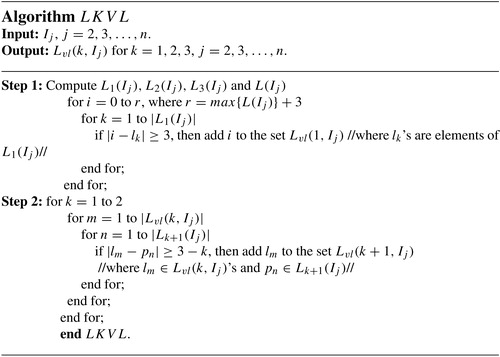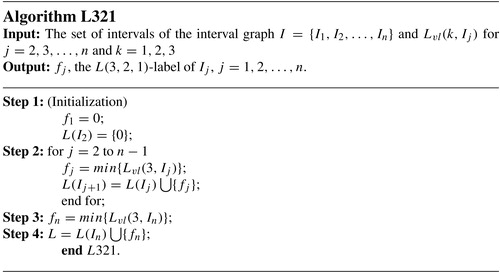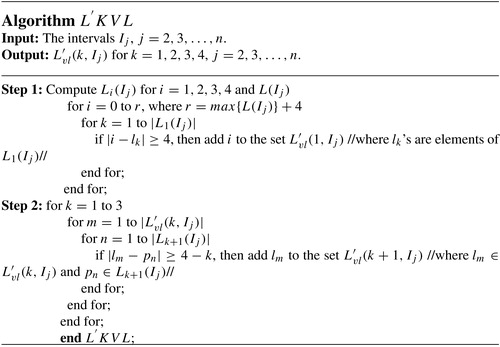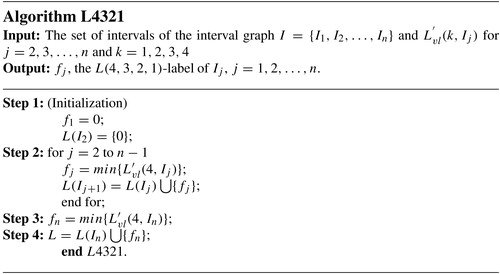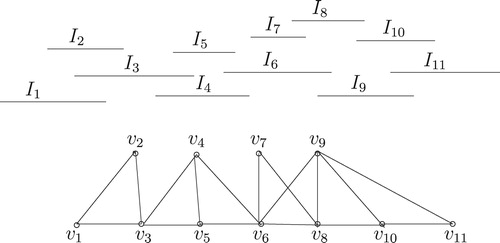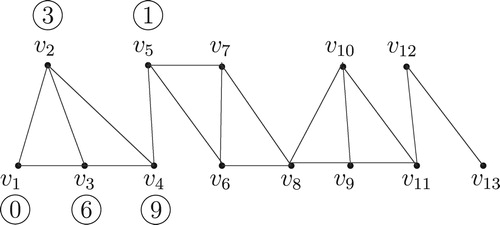 ?Mathematical formulae have been encoded as MathML and are displayed in this HTML version using MathJax in order to improve their display. Uncheck the box to turn MathJax off. This feature requires Javascript. Click on a formula to zoom.
?Mathematical formulae have been encoded as MathML and are displayed in this HTML version using MathJax in order to improve their display. Uncheck the box to turn MathJax off. This feature requires Javascript. Click on a formula to zoom.Abstract
For a given graph , the
- and
-labeling problems assign the labels to the vertices of
. Let
be the set of non-negative integers. An
- and
-labeling of a graph
is a function
such that
, for
respectively, where
represents the distance (minimum number of edges) between the vertices
and
, and
. The
- and
-labeling numbers of a graph
, are denoted by
and
and they are the difference between highest and lowest labels used in
- and
-labeling respectively. In this paper, for an interval graph
, it is shown that
and
, where
represents the maximum degree of the vertices of
. Also, two algorithms are designed to label an interval graph by maintaining
- and
-labeling conditions. The time complexities of both the algorithms are
, where
represent the number of vertices of
.
1 Introduction
The frequency assignment problem is a problem where the task is to assign a frequency (non-negative integer) to a given group of televisions or radio transmitters so that interfering transmitters are assigned frequency with at least a minimum allowed separation. A frequency assignment problem is motivated from the distance labeling problem of graphs. It is to find a proper assignment of channels to transmitters in a wireless network. The level of interference between any two radio stations correlates with the geographic locations of the stations. Closer stations have a stronger interference and thus there must be a greater difference between there assigned channels.
Table
Table
The frequency assignment problem was formulated as a vertex colouring problem of graph by Hale [Citation1]. In, 1988, Roberts proposed a variation of the frequency assignment problem in which ‘closed’ transmitter must receive different frequency and ‘very closed’ transmitter must receive a frequency at least two apart. Two vertices and
are said to be ‘very closed’ and ‘closed’ if the distance between
and
is
and
respectively. Griggs and Yeh [Citation2] defined the
-labeling of a graph
as a function
from the vertex set
to the set of non-negative integers such that
if
and
if
, where
represent the distance between the vertices
and
. The minimum span over all possible labeling functions of
-labeling is denoted by
and is called
number of
.
Similarly, an -labeling of a graph
is a function
from its vertex set
to the set of non-negative integers such that
if
,
if
and
if
. The
-labeling number,
, of
is the smallest non-negative integer
such that
has a
-labeling of span
. Also, an
-labeling of a graph
is a function
from its vertex set
to the set of non-negative integers such that
if
,
if
,
if
and
if
. The
-labeling number,
, of
is the smallest non-negative integer
such that
has a
-labeling of span
. Frequency assignment problem has been widely studied in the past [3–6Citation[3]Citation[4]Citation[5]Citation[6]]. In 2007, Bertossi et al. have studied approximate
-coloring of trees and interval graphs [Citation7] and Bodlaender et al. have studied about approximations for
-colorings of graphs [Citation8]. Also in [Citation9], Khan et al. have studied
-total labeling of cactus graphs and in [Citation10] they studied
-labeling of cactus graphs. Later Calamoneri [Citation11] studied
-labeling of eight grids, Amanathulla and Pal studied
-labeling and
-labeling of circular-arc graphs [Citation12]. We focus our attention on
-labeling and
-labeling of interval graphs. Different bounds for
and
were obtained for various type of graphs. The upper bound of
of any graph
is
[Citation13], where
is the degree of the graph. In [Citation14], Clipperton et al. showed that
for any graph. Later Chai et al. [Citation15] improved this upper bound and showed that
for any graph. In [Citation16], Lui and Shao studied the
-labeling of planer graph and showed that
. In [Citation15], Chia et al. also showed that
if
is a complete
-ary tree of height
and for any tree
. In [Citation17], Jean studied about
-labeling of simple graph and showed that
, where
is complete graph with
vertices and also shown that
. Kim et al. [Citation18] show that
when
and
, where
is the Cartesian product of complete graphs
and the cycle
. Again, Clipperton [Citation19] have shown that
for any graph
. In [Citation20], Paul et al. showed that
for interval graph and they also shown that
for circular-arc graph, where
represents the size of the maximum clique, also in [Citation21] they have shown that the value of
can be computed for interval graph using polynomial time. Recently, Paul et al. have studied a linear time algorithm to compute square of interval graphs and their colouring [Citation22]. Calamoneri et al. [Citation23] have shown that
and
for circular-arc graphs. Also in [Citation12], Amanathulla and Pal have shown that
and
for circular-arc graphs and they have also shown that
,
for circular-arc graphs [Citation24] and
if
and
if
for permutation graphs [Citation25].
In this paper, for interval graphs , it is shown that the upper bounds of
- and
-labeling are
and
respectively, where
represents the maximum degree of the vertices. Also two algorithms are designed to label an interval graph by
- and
-labeling. The time complexities of both the algorithms are
, where
represent the number of vertices of
.
The remaining part of the paper is organized as follows. Some notations and definitions are presented in Section 2. In Section 3, some lemmas related to our work and an algorithm to -label an interval graphs are presented. Section 4 is devoted to
-labeling problem of interval graphs. In Section 5, a conclusion is made.
2 Preliminaries and notations
The graphs used in this work are simple, finite, without self loop or multiple edges. A graph is called an intersection graph for a finite family
of a non-empty set if there is a one-to-one correspondence between
and
such that two sets in
have non-empty intersection if and only if there corresponding vertices in
are adjacent to each other. We call
an intersection model of
. For an intersection model
, we use
to denote the intersection graph for
. Depending on the nature of the set
one gets different intersection graphs. The class of interval graph is a very important subclass of intersection graph [26–28Citation[26]Citation[27]Citation[28]]. In [Citation29] Pal et al. discussed, a data structure on interval graphs and its applications. Let
, where
be a set of intervals on a real line,
and
are respectively the left and right end points of the interval
. We draw a vertex
for the interval
. Two vertices
and
are adjacent if and only if there corresponding intervals have non empty intersection. Thus an undirected graph
is an interval graph if the vertex set
can be put into one-to-one correspondence with a set of intervals
on the real line such that two vertices are adjacent in
if and only if there corresponding intervals have non empty intersection. Also, it is observed that an interval
of
and a vertex
of
are one and same thing. We assume that the intervals in
are indexed by increasing left end points, that is,
, i.e.
. This indexing is known as
ordering. An interval representation and its corresponding interval graphs are shown in .
For any interval graph and its interval representation
, we define the following notations:
| 1. |
| ||||
| 2. |
| ||||
| 3. |
| ||||
| 4. |
| ||||
| 5. |
| ||||
| 6. |
| ||||
3 
 -labeling of interval graphs
-labeling of interval graphs
In this section, we introduced some results which are used to find the upper bound of -labeling. Also, these results are used to design the algorithm.
Lemma 1
For an interval graph ,
,
for any interval
of
.
Proof
Let be an interval graph. we start the labeling of the graph from the leftmost interval. Let
be the vertex of the graph
corresponding to the interval
. We consider a situation in which the intervals
(for
) are already labeled by
-labeling and the remanning intervals are not labeled.
Case 1:
Let . This implies that
distinct labels are used to label the intervals at distance two from the interval
, before labeling the interval
.
Since, is an interval graph and
be the degree of the graph
, so there exists an interval
(in ) which is adjacent to at most
intervals of
. In ,
is adjacent to
. Among the intervals, some intervals (
in ) are of distance two from
and among these intervals at least one interval (
in ) is not at distance two from
. Therefore,
, i.e.
.
Case 2:
Let . This implies that
distinct labels are used to label the intervals at distance three from the interval
, before labeling the interval
. Since,
is an interval graph, so among the intervals at distance two from
, there exists an interval
(in ) which is adjacent to at most
intervals (
) of
. Among these intervals some intervals (
in ) are of distance three from the interval
. And also among the intervals there exists at least one interval (
in ) which is adjacent to
but not at distance three from
. So,
. Hence,
.
Case 3:
This case is similar to the previous cases. □
Lemma 2
For any interval graph ,
, for any interval
,
.
Proof
According to the definition, is the set of used labels before labeling the interval
. So any label
implies
, for
. Hence
. □
Theorem 1
For any interval graph , the
-labeling number
is at most
, where
is the degree of the graph
.
Proof
Let the number of vertices of the graph be
and let
, where
is the interval corresponding to the vertex
of the graph
. We shall label the intervals in ascending order of their subscripts.
Let , where
. Then
. If the set
is sufficient to label all the intervals corresponding to all the vertices of the graph
satisfying
-labeling condition, then we can say that
. We consider a situation in which the intervals
, for
are already labeled and
are not labeled. In this case, we want to label the interval
. We know that
. So, in worst case
labels of the set
are available, which satisfies the condition of distance one of
-labeling.
Also, since, (By Lemma 1), so in worst case
labels of the set
are available, which satisfies the condition of distance one and two of
-labeling. Again, since,
(By Lemma 1), so in the extreme unfavourable cases at least one (viz.
) label of the set
is available satisfying
-labeling condition. Since
is arbitrary so we can label any interval of the interval graph
satisfying
-labeling condition by using only the label of the set
. If we take
so that
and in similar manner we are going to label the interval
by
-labeling, then it follows that the set
may or may not contain a label satisfying
-labeling condition. Therefore,
. Hence, the
-labeling number for interval graph is at most
. □
3.1 Algorithm for 
 -labeling
-labeling
In this section, we design an algorithm to compute the set for
and
and also we design an algorithm to
-label an interval graph. We consider a situation in which some intervals (the intervals
’s with index
) are labeled by
-labeling and some intervals (the intervals
’s with index
) are not labeled.
Lemma 3
Algorithm ,
correctly compute
for
and the running time for this algorithm is
.
Proof
According to this algorithm every element is differ from
by at least
for each
. So,
for all
and for all
. So the algorithm correctly computes
.
Again, according to the above algorithm for each every element
of
is differ from
by at least
for each
. So,
for all
and for all
, for
. Hence the algorithm correctly computes
for
.
Since is the label set and
be its cardinality, clearly
for
and for any
and also
, where
. So we can compute
using at most
times, i.e. using
times. Also,
, for
. So for each
can be computed using at most
times, i.e. using
times. So the time complexity of the algorithm
is
, i.e.
, since
. □
Lemma 4
For any interval graph and for any
,
is the largest non empty set satisfying the condition of distance
for
, of
-labeling, where
for all
and
, for any
and
.
Proof
Since, and
for
(By Lemma 2), so
for any
. Therefore,
for
. Hence, for any
,
is non empty. Again, let
be any set of labels satisfying the condition of distance
for
, of
-labeling, where
for all
. Also, let
. Then
for any
and for
, where
. Thus,
, for
. Therefore,
implies
, for
. So,
, for
. Since
is arbitrary, so for any
,
is the largest non empty set of labels satisfying the condition of distance
for
of
-labeling, where
and for all
. □
Theorem 2
Algorithm correctly labels an interval graph satisfying
-labeling condition.
Proof
Let be an interval graph with
vertices. Let
be the set of intervals of the interval graph, also let
,
. If
, then
is sufficient to label the whole graph and obviously,
. If
, then
is not sufficient to label the graph
by
-labeling, because in this case more than one label is required and
contains only one label.
We consider a situation in which the intervals are already labeled for
. In this situations we want to label the interval
by
-labeling. We know that
is the largest non-empty set satisfying the condition of distance
for
of
-labeling, where
for all
and
for any
and
(By Lemma
). Again, no label
and
satisfying
-labeling condition. So the labels on the set
is the only valid label for
, which is less than or equal to
and satisfying
-labeling condition. Since we want to label the interval
by
-labeling, so,
, where
. Then
is the least label for
, because no label less than
satisfies
-labeling condition. Since,
is arbitrary so by Algorithm
the graph
can be labeled using minimum number of labels satisfying
-labeling condition and
. □
Theorem 3
The time complexity of Algorithm is
, where
is the number of vertices of the graph and
is the degree of the graph.
Proof
In Algorithm , our aim is to find least possible label for each interval
. By our proposed algorithm it is clear that
can be computed if
is computed. Now by Lemma 3, Algorithm
for
takes
time to compute
. Since we need to find
for
, so the overall time complexity of Algorithm
is
, i.e.
. □
Illustration of Algorithm
We consider an interval graph with vertices (see ) and labeled this graph by Algorithm
.

For this graph, and
.
the label of the interval
, for
.
,
.
Iteration 1: For .
,
,
.
,
,
.
Therefore, and
.
Iteration 2: For .
,
,
.
,
,
.
So and
.
Iteration 3: For .
,
,
.
,
,
.
Therefore, and
.
Iteration 4: For .
,
,
.
,
,
.
Therefore, and
.
After iteration the graph becomes: (see ).
Iteration 5: For .
,
,
.
,
,
.
Therefore, and
.
In this way, ,
,
,
,
,
and finally,
.
The vertices and the label of the corresponding vertices are given below:
4 
 -labeling of interval graphs
-labeling of interval graphs
By extending the idea of -labeling of interval graphs, we present an algorithm for
-labeling of the interval graphs. In this section, we present some lemmas related to our work, upper bound of
-labeling, Algorithm
and time complexity of the proposed algorithm
and finally an illustration of Algorithm
.
Theorem 4
For any interval graph , the
-labeling number
is at most
, where
is the degree of the graph
.
Proof
Let be an interval graph with
vertices and let
, where
is the interval corresponding to the vertex
of the graph
. We label the intervals in ascending order of the subscript of the intervals.
Let , where
. Then
. If the set
is sufficient to label all the intervals corresponding to all the vertices of the graph
satisfying
-labeling condition, then we can say that
. We consider a situations in which the intervals
, for
are already labeled and
are not labeled. In this case, we label the interval
by
-labeling. We know that
. So in worst case
labels of the set
are available to label the intervals which are at distance one from the interval
.
Also, since, (By Lemma 1), so in worst case
labels of the set
are available which satisfies the conditions of distance one and two of
-labeling. Again, since,
(By Lemma 1), so in extreme unfavourable cases
labels of the set
are available which satisfies the conditions of distance one, two and three of
-labeling. Again, since,
(By Lemma 1), so in the extreme unfavourable cases at least one (viz.
) label of the set
is available which satisfies
-labeling condition. Since
is arbitrary, so we can label any interval of the interval graph
satisfying
-labeling condition by using only the label of the set
.
Thus, using the labels of the set one can
-label the interval graph
. Therefore,
. □
4.1 Algorithm for 
 -labeling
-labeling
In this subsection, an algorithm to compute the set for
and
is designed and also we design an algorithm to
-label an interval graph. We consider a situation in which some intervals (the intervals
’s with index
) are labeled by
-labeling and some intervals (the intervals
’s with index
) are not labeled.
Lemma 5
Algorithm ,
correctly compute
for
and the running time for this algorithm is
.
Proof
According to this algorithm every element is differ from
by at least
for each
. So,
for all
and for all
. So the algorithm correctly computes
.
Again, according to the above algorithm for each every element
of
is differ from
by at least
for each
. So,
for all
and for all
, for
. Hence the algorithm correctly compute
for
.
Since is the label set and
be its cardinality, clearly
for
and for any
and also
, since
. So we can compute
using at most
times, i.e. using
times. Also,
, for
. So for each
can be computed using at most
times, i.e. using
times. So the time complexity of the algorithm
is
, i.e.
, since
. □
Lemma 6
For any interval graph and for any
,
is the largest non empty set satisfying the condition of distance
for
of
-labeling, where
for all
and
, for any
and
.
Proof
Since, and
for
(By Lemma 2), so
for any
. Therefore,
for
. Hence, for any
,
is non empty. Again, let
be any set of labels satisfying the condition of distance
for
of
-labeling, where
for all
. Also, let
. Then
for any
and for
, where
. Thus,
, for
. Therefore,
implies
, for
. So,
, for
. Since
is arbitrary, so for any
,
is the largest non empty set of labels satisfying the condition of distance
for
of
-labeling, where
and for all
. □
Theorem 5
Algorithm correctly labels an interval graph satisfying
-labeling condition.
Proof
Let be an interval graph with
vertices. And let the set of intervals of the interval graph be
, also let
,
. If
, then
is sufficient to label the whole graph and obviously,
. If
, then
is not sufficient to label the graph
by
-labeling, because in this case more than one label is required and
contains only one label.
We consider a situation in which the intervals are already labeled for
. In this case, we label the interval
by
-labeling. We know that
is the largest non-empty set satisfying the condition of distance
for
of
-labeling, where
for all
and
for any
and
(By Lemma
). Again no label
and
satisfying
-labeling condition. So the labels on the set
is the only valid label for
, which is less than or equal to
and satisfies
-labeling condition. Since we want to label the interval
by
-labeling, so,
, where
. Then
is the least label for
, because no label less than
satisfies
-labeling condition. Since,
is arbitrary so by Algorithm
the graph
can be labeled using minimum number of labels satisfying
-labeling condition and
. □
Theorem 6
The time complexity of Algorithm is
, where
is the number of vertices of the graph and
is the degree of the graph.
Proof
In Algorithm , our aim is to find the least possible label for each interval
. By our proposed algorithm it is clear that
can be computed if
is computed. Now by Lemma
,
for
takes
time to compute
. Since we need to find
for
, so the overall time complexity of Algorithm
is
, i.e.
. □
Illustration of Algorithm
We consider an interval graph with vertices (see ) and label this graph by Algorithm
.
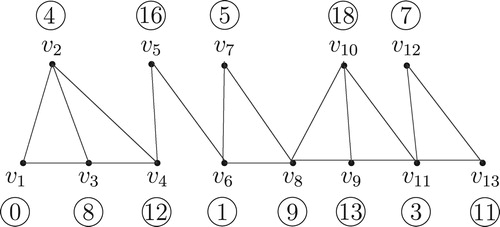
For this graph, and
.
, the label of the vertex
, for
.
,
.
Iteration 1: For .
,
,
,
.
,
,
,
.
Therefore, and
.
Iteration 2: For .
,
,
,
.
,
,
,
.
Therefore, and
.
Iteration 3: For .
,
,
,
.
,
,
,
.
Therefore, and
.
Iteration 4: For .
,
,
,
.
,
,
,
.
Therefore, and
.
After iteration the graph becomes: (see ).
Iteration 5: For .
,
,
,
.
,
,
,
.
Therefore, and
.
In this way, ,
,
,
,
,
and finally,
.
The vertices and the label of the corresponding vertices are shown below:
5 Conclusion
In this paper, we determine the upper bounds for and
for an interval graph
, and have shown that
and
. These bounds are tighter than the previous available result [Citation7]. Also, two algorithms are designed to
-label and
-label for interval graphs. The running time for both the algorithms are
. We feel that the computation of exact value of
and
for an interval graph is very difficult. Since the result is not exact, so there is a chance for new upper bounds for the problems. Also the time complexities of the proposed algorithms may be reduced.
Notes
Peer review under responsibility of Kalasalingam University.
References
- W.K.HaelFrequency assignment: theory and applicationsProc. IEEE68198014971514
- J.GriggsR.K.YehLabeling graphs with a condition at distance twoSIAM J. Discrete Math.51992586595
- G.J.ChangC.LuDistance two labelling of graphsEuropean J. Combin.2420035358
- S.H.ChiangJ.H.YanOn L(d,1)-labeling of cartesian product of a pathDiscrete Appl. Math.15615200828672881
- S.PaulM.PalA.PalL(2,1)-labeling of circular-arc graphAnn. Pure Appl. Math.522014208219
- D.SakaiLabeling chordal graphs with a condition at distance twoSIAM J. Discrete Math.71994133140
- A.A.BertossiC.M.PinottiApproximate L(δ1,δ2,…,δt)-coloring of trees and interval graphsNetworks4932007204216
- H.L.BodlaenderT.KloksR.B.TanJ.V.LeeuwenApproximations for λ-colorings of graphsComput. J.4722004193204
- N.KhanM.PalA.PalL(2,1)-total labeling of cactus graphsInternat. J. Inform. Comput. Sci.542010243260
- N.KhanM.PalA.PalL(0,1)-labeling of cactus graphsCommun. Network420121829
- T.CalamoneriL(δ1,δ2,1)-labeling of eight gridsInform. Process. Lett.1132013361364
- Sk.AmanathullaM.PalL(0,1)- and L(1,1)-labeling problems on circular-arc graphsInt. J. Soft Comput.1162016343350
- T.CalamoneriThe L(h,k)-labeling problem: an updated survey and annotated bibliographyComput. J.548201113441371
- J.ClippertonJ.GehrtzZ.SzaniszloD.TorkornooL(3,2,1)-labeling of Simple Graphs2006VERUM, Valparaiso University
- M.L.ChiaD.QuaH.LiaoC.YangR.K.YeaL(3,2,1)-labeling of graphsTaiwanese J. Math.156201124392457
- J.LiuZ.ShaoThe L(3,2,1)-labeling problem on graphsMath. Appl.1742004596602
- J.ClippertonL(d,2,1)-labeling of simple graphsMath J.92008111
- B.M.KimW.HwangB.C.SongL(3,2,1)-labeling for product of a complete graph and cycleTaiwanese J. Math.201410.11650/tjm.18.2014.4632
- J.ClippertonL(4,3,2,1)-labeling of simple graphsAppl. Math. Sci.12201195102
- S.PaulM.PalA.PalL(2,1)-labeling of interval graphJ. Appl. Math. Comput., ISSN4912015419432
- S.PaulM.PalA.PalAn efficient algorithm to solve L(0,1)-labeling problem on interval graphsAdv. Model. Optim.1512013113
- S.PaulM.PalA.PalA linear time algorithm to compute square of interval graphs and their colouringAKCE Int. J. Graphs Comb.13120165464
- T.CalamoneriG.EmanueleFuscoRichard B.TanPaola Vocca, L(h,1,1)-labeling of outerplanar graphsMath. Meth Oper. Res.692009307321
- Sk.AmanathullaM.PalL(3,2,1)- and L(4,3,2,1)-labeling problems on circular-arc graphsInt. J. Control Theory Appl.9342016869884
- Sk.AmanathullaM.PalL(3,2,1)-labeling problems on permutation graphsTransylv. Rev.2514201739393953
- M.PalG.P.BhattacharjeeOptimal sequential and parallel algorithms for computing the diameter and the center of an interval graphInt. J. Comput. Math.591995113
- M.PalG.P.BhattacharjeeAn optimal parallel algorithm to color an interval graphParallel Process. Lett.61996439449
- M.PalIntersection graphs: An introductionAnn. Pure Appl. Math.420134193
- M.PalG.P.BhattacharjeeA data structure on interval graphs and its applicationsJ. Circuits Syst. Comput.71997165175

